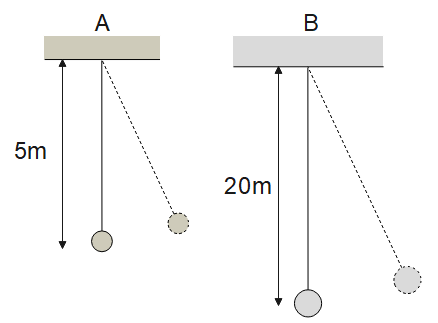
Two simple pendulums of length 5m and 20m respectively are given small linear displacement in one direction at the same time. They will again be in the phase when the pendulum of shorter length has completed n oscillations. The value of n is then:
(A) 5
(B) 1
(C) 2
(D) 3
Answer
539.1k+ views
Hint: The time period of a simple pendulum T, depends on the length of the pendulum l and the acceleration due to gravity g. Time period T is directly proportional to the square root of the length of the pendulum l. By equating the two time periods we get the value of n.
Complete answer:
According to the question, we have two simple pendulums A and B of length ${{l}_{1}}=5$m and ${{l}_{2}}=20$m respectively, which are given small linear displacement in one direction at the same time, as shown in the diagram below.

Now, let us calculate the time period of pendulum A,
${{T}_{1}}=2\pi \sqrt{\dfrac{{{l}_{1}}}{g}}=2\pi \sqrt{\dfrac{5}{10}}=\sqrt{2}\pi $ ….(i) [ taking acceleration due to gravity $g=10$m/${{s}^{2}}$]
Then, time period of pendulum B is given by,
${{T}_{2}}=2\pi \sqrt{\dfrac{{{l}_{2}}}{g}}=2\pi \sqrt{\dfrac{20}{10}}=2\sqrt{2}\pi $ ….(ii) [ taking acceleration due to gravity $g=10$m/${{s}^{2}}$]
Now, to calculate the number of oscillations n of the pendulum A after which the two pendulums A and B will be in the phase, we compare the time period of pendulum A and time period of pendulum B calculated in equations (i) and (ii), we get,
${{T}_{2}}=2{{T}_{1}}$ ….(iii)
Therefore, we see from the above equation that the time period of pendulum A is twice the time period of pendulum B, i.e. after 2 oscillations of pendulum A, the two pendulums A and B will be in the phase.
Thus, the correct answer is option (C).
Note:
The formula of the time period of a simple pendulum should be remembered to solve such questions. The standard value of acceleration due to gravity g is $9.8$ m/${{s}^{2}}$, however we can take $g=10$m/${{s}^{2}}$to make the calculations simple and less time taking.
Complete answer:
According to the question, we have two simple pendulums A and B of length ${{l}_{1}}=5$m and ${{l}_{2}}=20$m respectively, which are given small linear displacement in one direction at the same time, as shown in the diagram below.

Now, let us calculate the time period of pendulum A,
${{T}_{1}}=2\pi \sqrt{\dfrac{{{l}_{1}}}{g}}=2\pi \sqrt{\dfrac{5}{10}}=\sqrt{2}\pi $ ….(i) [ taking acceleration due to gravity $g=10$m/${{s}^{2}}$]
Then, time period of pendulum B is given by,
${{T}_{2}}=2\pi \sqrt{\dfrac{{{l}_{2}}}{g}}=2\pi \sqrt{\dfrac{20}{10}}=2\sqrt{2}\pi $ ….(ii) [ taking acceleration due to gravity $g=10$m/${{s}^{2}}$]
Now, to calculate the number of oscillations n of the pendulum A after which the two pendulums A and B will be in the phase, we compare the time period of pendulum A and time period of pendulum B calculated in equations (i) and (ii), we get,
${{T}_{2}}=2{{T}_{1}}$ ….(iii)
Therefore, we see from the above equation that the time period of pendulum A is twice the time period of pendulum B, i.e. after 2 oscillations of pendulum A, the two pendulums A and B will be in the phase.
Thus, the correct answer is option (C).
Note:
The formula of the time period of a simple pendulum should be remembered to solve such questions. The standard value of acceleration due to gravity g is $9.8$ m/${{s}^{2}}$, however we can take $g=10$m/${{s}^{2}}$to make the calculations simple and less time taking.
Recently Updated Pages
Why are manures considered better than fertilizers class 11 biology CBSE

Find the coordinates of the midpoint of the line segment class 11 maths CBSE

Distinguish between static friction limiting friction class 11 physics CBSE

The Chairman of the constituent Assembly was A Jawaharlal class 11 social science CBSE

The first National Commission on Labour NCL submitted class 11 social science CBSE

Number of all subshell of n + l 7 is A 4 B 5 C 6 D class 11 chemistry CBSE

Trending doubts
What is meant by exothermic and endothermic reactions class 11 chemistry CBSE

10 examples of friction in our daily life

One Metric ton is equal to kg A 10000 B 1000 C 100 class 11 physics CBSE

1 Quintal is equal to a 110 kg b 10 kg c 100kg d 1000 class 11 physics CBSE

Difference Between Prokaryotic Cells and Eukaryotic Cells

What are Quantum numbers Explain the quantum number class 11 chemistry CBSE




